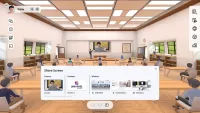
Author: Kevin Chu, Director, UNIVERSE by ViewSonic Business Unit

New digital technologies offer unprecedented ways to transform learning. ViewSonic’s innovative EdTech solutions are embracing these possibilities more than ever, shaping the methods of how we learn, teach and structure educational models in online and offline settings.
The online learning market has grown over 150% since 2017 and is projected to reach 238 billion USD by 2027. With the surge in demand, the online education sector has shifted to asynchronous learning, where students access pre-recorded course materials on their own time. However, students started to miss out on the benefits of learning in a traditional classroom – including the ability to effectively engage with the class and create meaningful connections.

Aiming to achieve a more student-centric approach to learning online, ViewSonic, known for delivering innovative and reliable education solutions worldwide, developed UNIVERSE by ViewSonic, a virtual world built for education that brings the benefits of in-person learning to an immersive online environment.

The application increases student engagement, encourages peer-to-peer collaboration, and fosters a sense of belonging among students during any form of learning that happens online. With this unique setting, UNIVERSE moves online learning from a static 2D, unidirectional flow to a 3D immersive environment, incorporating successful in-person teaching methods in a virtual space. Built with virtual spaces such as classrooms and collaborative areas, students can interact and navigate around a digital campus. By joining classes through customizable avatars instead of using the camera, students can create a persona they want to portray. The anonymity of being behind an avatar can reduce anxiety and encourage participation.

When rolling out UNIVERSE by ViewSonic, the platform was deployed to some schools in Taiwan to gauge teachers’ reactions and gain feedback from both teachers and students. According to Mr. Chu, one of the math teachers at Chung-Hwa Junior High School, “UNIVERSE simulates real-life classroom settings very well, and it has everything a teacher needs in a single place”. From quizzing students in real-time, to allowing them to run around the campus after class, teaching in UNIVERSE feels closer to teaching in real-life than the traditional video conferencing platforms. Among other features to improve student collaboration, Mr. Chu highlighted the usefulness of sending students into breakout rooms for more focused group work.
The creation of alternative ways to approach online learning is one of the most exciting EdTech developments of recent years. Although the current go-to learning platforms struggle with retaining student’s engagement, there already is technology available to support teachers and students better collaborate in a virtual setting. The future path of education clearly leads to increasing digitalization of teaching materials, methods and environments. Leveraging wireless and mobile technologies can equalize educational opportunities and allow students to experience a more student-centric approach online.
“This content is provided by the company and the website will not be responsible in any way for the content of this article.”
